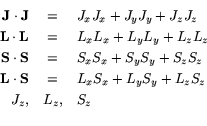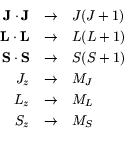We start in a stationary state ![]() . We wait a bit. Under the influence
of the electromagnetic perturbation
. We wait a bit. Under the influence
of the electromagnetic perturbation ![]() ,
, ![]() evolves to a state which is a
superposition of
evolves to a state which is a
superposition of ![]() and other stationary states
and other stationary states ![]() . What can we say
about the possible
. What can we say
about the possible ![]() ?
?
At first you might guess that one could not say anything without a detailed
study of ![]() . Say
. Say ![]() is a basis of eigenvectors of
is a basis of eigenvectors of ![]() .
Expand
.
Expand ![]() out in this basis:
out in this basis:
Let's rephrase this without so many indices. ![]() has a matrix
representation in the basis of eigenvectors of
has a matrix
representation in the basis of eigenvectors of ![]() . ``Immediate''
transitions between ``stationary states'' (i.e., eigenvectors of
. ``Immediate''
transitions between ``stationary states'' (i.e., eigenvectors of ![]() ) come
from non-zero off-diagonal entries in the
) come
from non-zero off-diagonal entries in the ![]() matrix.
matrix.
Over longer periods of time, we can have transitions through intermediate
states:
![]() . If you work through the
math, you will find out that you are computing
. If you work through the
math, you will find out that you are computing ![]() ,
, ![]() , etc., for
these indirect transitions; the power series for
, etc., for
these indirect transitions; the power series for ![]() makes an
appearance in the final result.
makes an
appearance in the final result.
The moral of this tale is that zero entries in the ![]() matrix correspond
to forbidden transitions. A selection rule translates into an assertion
about the form of the
matrix correspond
to forbidden transitions. A selection rule translates into an assertion
about the form of the ![]() matrix. And so, it appears, we need a detailed
study of
matrix. And so, it appears, we need a detailed
study of ![]() to determine the selection rules.
to determine the selection rules.
Our crude ``derivation'' of the selection rules for ![]() indeed depended on
the ``mechanism'' of light. But for
indeed depended on
the ``mechanism'' of light. But for ![]() , we appealed to a general physical
principle, conservation of angular momentum. Can one not translate this
argument into quantum mechanics?
, we appealed to a general physical
principle, conservation of angular momentum. Can one not translate this
argument into quantum mechanics?
One can. The thread runs thus: ![]() must be invariant under all spatial
rotations, for electromagnetism does not single out any preferred direction
in space. So the group of spatial rotations,
must be invariant under all spatial
rotations, for electromagnetism does not single out any preferred direction
in space. So the group of spatial rotations, ![]() , must play a special
role. At this point group representation theory takes over, and out pops
the selection rules for
, must play a special
role. At this point group representation theory takes over, and out pops
the selection rules for ![]() and
and ![]() . (You do need some additional
assumptions I won't spell out.)
. (You do need some additional
assumptions I won't spell out.)
Let's take a last look at the Paschen-Back effect, using all we've learned.
Where do the ![]() selection rules leave off and the
selection rules leave off and the ![]() and
and ![]() selection rules take over, as we increase the magnetic field?
selection rules take over, as we increase the magnetic field?
Both sets of selection rules hold throughout! The trick is picking the right basis. To understand this, we must consider again the combined influence of the spin-orbit and magnetic perturbations.
The operator ![]() looks like this:
looks like this:
B is just a conventional 3-space vector, but L, S, and
J are all ``operator vectors''. That is, for any coordinate system,
we have
![]() , where
, where ![]() ,
, ![]() , and
, and ![]() are all
operators. Ditto for S and J.
are all
operators. Ditto for S and J.
Pick the ![]() -axis in the direction of the magnetic field. Several
operators now demand a role:
-axis in the direction of the magnetic field. Several
operators now demand a role:


Finding additional ``good'' quantum numbers proves more frustrating.
![]() commutes with
commutes with ![]() and with
and with
![]() , but not
with
, but not
with ![]() or
or ![]() (as it happens). Drop the
(as it happens). Drop the
![]() term
from
term
from ![]() , and we have
, and we have ![]() and
and ![]() as good quantum numbers. Alternately,
drop the spin-orbit coupling term, and, as luck will have it,
as good quantum numbers. Alternately,
drop the spin-orbit coupling term, and, as luck will have it, ![]() and
and
![]() become good quantum numbers.
become good quantum numbers.
So we have a choice of bases. With no field, we can find stationary states
with sharp values of ![]() . With no spin-orbit coupling, we can
demand sharp values for
. With no spin-orbit coupling, we can
demand sharp values for ![]() .
.
Start with the ![]() basis, and turn on a weak field. The states
are now only approximately stationary (even in Bohr's sense). The stronger
the field, the less accurate the approximation. But the matrix elements
for
basis, and turn on a weak field. The states
are now only approximately stationary (even in Bohr's sense). The stronger
the field, the less accurate the approximation. But the matrix elements
for ![]() , in this basis, strictly obey the
, in this basis, strictly obey the ![]() and
and ![]() selection rules, no
matter how strong the field.
selection rules, no
matter how strong the field.
For a very strong field, the ![]() basis consists of
approximately stationary states (i.e., near-eigenvectors of
basis consists of
approximately stationary states (i.e., near-eigenvectors of ![]() ). The
). The
![]() and
and ![]() selection rules hold strictly with respect to this basis,
no matter how weak the field. (The
selection rules hold strictly with respect to this basis,
no matter how weak the field. (The ![]() and
and ![]() selection rules hold for
either basis.)
selection rules hold for
either basis.)
Just to hose away the last traces of the muddle: how can we reconcile
![]() with the formulas
with the formulas
![]() and
and
![]() ? (We needed the latter two formulas for the anomalous Zeeman effect.)
Answer: Suppose an atom makes a transition from
? (We needed the latter two formulas for the anomalous Zeeman effect.)
Answer: Suppose an atom makes a transition from
![]() to
to
![]() (using the Dirac
(using the Dirac ![]() notation for
state-vectors, plus the ``colloquial'' abbreviations
notation for
state-vectors, plus the ``colloquial'' abbreviations
![]() ,
,
![]() ). The atom begins and
ends in an eigenstate of
). The atom begins and
ends in an eigenstate of ![]() . Each eigenstate is a ``blend'' of
eigenstates of
. Each eigenstate is a ``blend'' of
eigenstates of ![]() , say:
, say:

We have already seen this resolution foreshadowed in the classical
treatment, when we obtained the ``average'' ![]() -component of S by
taking the
-component of S by
taking the ![]() -component of
-component of
![]() . But classical mechanics
lacks the notion of ``blended'' states, and so is ill-equipped to pass
smoothly from the weak field to the strong field regime.
. But classical mechanics
lacks the notion of ``blended'' states, and so is ill-equipped to pass
smoothly from the weak field to the strong field regime.
So much for the Zeeman effect. Let us punctuate the tale with an anecdote. A friend ran into Heisenberg on the streets of Cophenhagen, around 1920; Heisenberg had a grim expression. ``Cheer up, Werner, things can't be that bad!'' Replied Heisenberg, ``How can one be cheerful when one is thinking about the anomalous Zeeman effect?''
© 2001 Michael Weiss